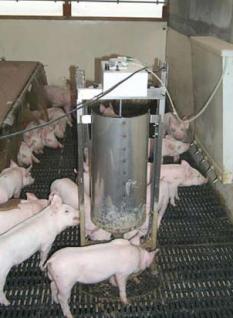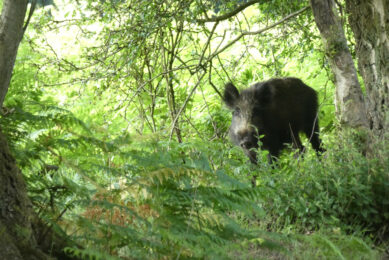Taking control of feed conversion ratio

Feed Conversion Ratio (FCR) is a reflection of performance in pig units. Feed intake and weight gain are the integral components but what influences these factors is more complex. And for this reason, FCR performance within a group of pigs can vary widely. More careful monitoring of the factors affecting FCR and means of improving it could be justified on most modern pig units.
By Dr Mike Varley, Consultant to SCA NuTec, Dalton, North Yorkshire, UK
The conversion of high quality feed into weight gain is of absolute importance in modern pig production, and especially as feed costs increase. How well this is achieved is reflected in the feed conversion ratio (FCR). FCR is built into most feed and performance recording systems as an axiomatic and necessary parameter.
Between 60 and 80% of the cost of production are feedstuffs and typically around two to three kilogrammes of feed results in a kilo of animal body weight gain. The closer this is to 2 kg the better – or lower – the FCR is. If the FCR is 2.0 then it takes 2 kg of feed to take a pig from 30 to 31 kg liveweight for example, as opposed to a 3.0 ratio where it takes 3 kg of feed to achieve the same 1 kg of body weight gain and the associated higher feed bill.
Most units will derive the index from the recorded feed consumption of a batch of pigs or the whole farm business over a defined time period compared to the weight gain of this same group of pigs or farm over the same time span.
The calculation for FCR is then:
FCR = Feed intake / Weight gain
The smaller the feed intake for a given weight accretion leads to a better – or smaller – FCR index. And this index is used in the UK and many parts of Europe. However, it is important to realise that, in the USA and other parts of the world a feed efficiency or gain:feed ratio is used and in these cases, the larger the index the better.
The equation shown for deriving FCR shows just how simple it is to calculate and how, on the most progressive farms, it can be done regularly. But it does not highlight the underlying principals involved.
Age is a determinant of feed conversion ratio – a newborn piglet will have an FCR below 1.0.
In reality, FCR is not an index based on the variables of growth rate and feed intake but on the factors affecting them. It is not just a calculated value but an independent biological factor that can be influenced by genetics, feeding practice, environmental control or health status.
A better management equation would be:
Growth rate (weight gain) = Feed intake/FCR
This is because both feed intake and FCR are totally independent variables whereas growth rate or weight gain is only derived from the other two parameters. Growth performance can be increased by increasing feed intake performance or improving (reducing) FCR.
Factors influencing FCR
Detailed records from either a commercial farm or a research farm shows the enormous variation in FCR month on month or trial on trial. And although the overall FCR average might be 2.2, within this average some batches will achieve an FCR of 1.8 and some will be 2.9.
If individual pigs are measured the range in FCRs is much greater. Some pigs will convert at 1.8 but some will return figures of 10.0 – that is 1 kg of weight gain for 10 kg of feed input. The wide variation may reflect the health status position within the herd and those needing 10 kg of feed for a 1 kg weight gain are obviously the clinically sick pigs. Even sub-clinically sick pigs will return FCRs of four or five.
A pig with severe diarrhoea may have a negative growth over a period of weeks and yet still consume a small amount of feed and can even have an FCR of more than 100. These ‘problem’ pigs can be picked up in a research trial but a commercial farm would not measure individuals so precisely. But it is important to appreciate the role of health status as a main driver in FCRs.
Age is another determinant of FCR and in general FCR gradually increases (gets worse) as the pig grows older. A newborn piglet will have an FCR below 1.0. This might seem impossible, but the piglet at this stage is just growing muscle and bone and muscle is nearly all water. The piglet is also consuming milk with more than 80% water content and hence it turns the water straight into body weight growth.
By the time the growing pig gets to slaughter weight the FCR has increased (worsened) to around three. The general trend for a modern genotype under good health conditions is shown in Figure 1, based on a prediction using the French INRA simulation model. Clearly, as the pig ages towards slaughter weight it is beginning to deposit lipid in the carcase and the feed energy cost of doing this drags down the efficiency, meaning that FCR gets higher.
High killing weight
Production systems in different regions such as Japan and Korea that are based on very high killing weights are therefore inevitably linked to poor feed conversion ratios. Killing at 100 to 110 kg live weight may hence optimise FCR with other production parameters.
Genetics is also a prime factor in controlling FCR expression. This area was a major selection criterion in many of the early genetic improvement programmes such as that run in the UK by the Meat & Livestock Commission.
The work was based on the fact that the genetic trait has a high heritability of between 0.5 and 0.7 and can be changed quickly over relatively few generations of selection effort. And because of the pig’s high reproductive rate, a high selection differential could be applied. Real and significant genetic progress was made in those early years.
Nowadays, genetic improvement is not in the public domain any longer in the UK or in most major pig industries. Genetic improvement rests with the commercial genetic companies and it is hoped that progress still continues.
The temptation for the genetic companies could be to select purely and simply on daily gain and feed intake, coupled with important carcass traits – because these are directly measured. It might be assumed that FCR, known to be negatively genetically correlated with both average daily gain and feed intake, improves with no further direct selection effort. This may well be untrue.
Over long time spans good progress has certainly been made in improving average daily gain and feed intake through genetic selection. Ignoring FCR as a selection criterion in selection indices may lead to a regression in this genetic characteristic.
Focus on health
Overall, the genetics of our modern high lean pigs does yield tremendous capacity for converting feed energy and protein into lean gain and this leaves health status as the single most important factor affecting FCR outside of nutritional factors.
High gut health status is inextricably linked to a very low FCR index. This was deduced back when antibiotics were allowed in feed to control gut flora and where this was the case then FCR was boosted.
Alternatively, feed additives such as organic acids, essential oils, oligosaccharides and immune-stimulators used for controlling gut health status can achieve just the same, if not better, results in FCR.
Although a generalisation, FCR tends not to be monitored on farms as closely as it should be and it’s impact on profitability is not fully appreciated. In the UK and in many other European industries there is now in place nationally coordinated pig health schemes to progressively improve health status. This is already beginning to have an impact on reducing the impact of some of the major endemic production diseases and this is showing good benefits on FCR expression.
Nutritional status
Undoubtedly, nutrition and feeding practices have a very large effect on the FCR under commercial conditions. The use of biphasic or multi-phase feeding systems where two or more formulations are used between 25 kg and 100 kg is essential to match nutrient requirements with nutrient supply at every stage to slaughter weight.
Cutting corners on feed and formulation work will have a very damaging influence on FCR which will end up costing more for the business rather than less. Monitoring raw material quality is necessary, and using tools such as NIR (Near Infra Red) analysis for those with home mixing facilities will check the precise composition of bought in raw materials – or compound feeds.
Any deviation from the optimum lysine:calorie, for example, at any stage of growth will have a significant FCR cost to the overall business.
For producers, a recommended practical solution is to monitor FCR month by month using total feed inputs against gross gain by batches of pigs going through. FCR is a major determinant of profitability so it is essential to keep it well under control.
Source: Pig Progress Volume 25 nr 2











